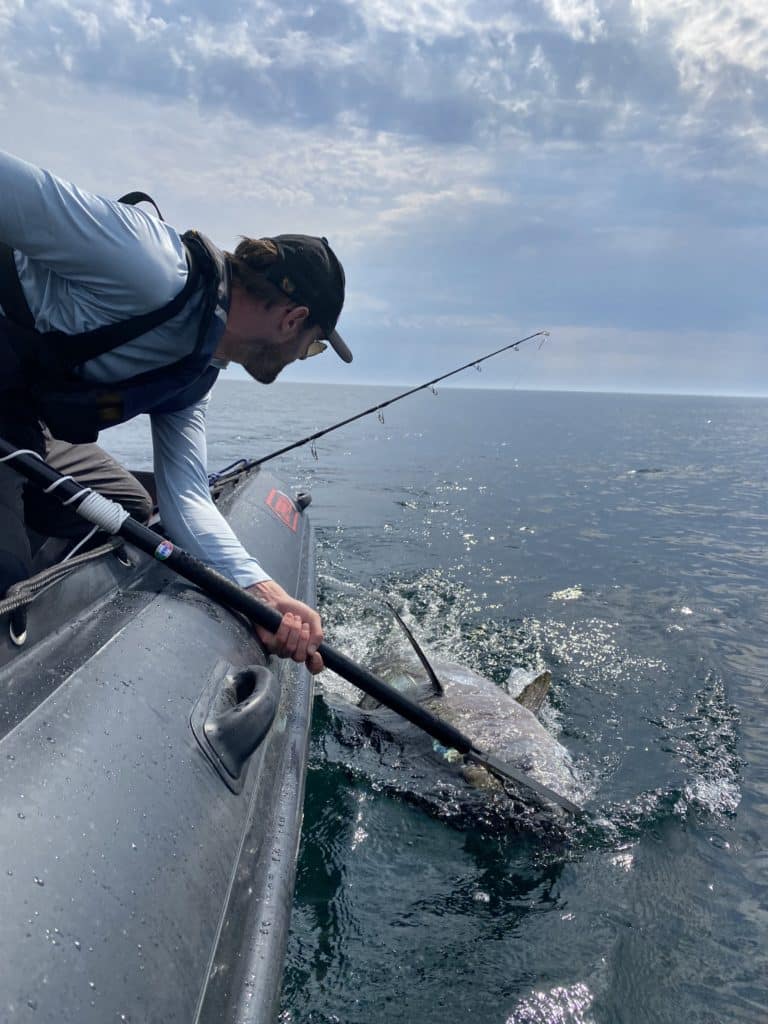The bluefin tuna is without doubt the most powerful fish to be found on our coasts, and for good reason our Breton waters are home to some of the largest specimens on the French coastline. The average size is exceptional, with fish over 1.80 metres in length not uncommon and record specimens weighing in at over 200 kilos. Its lure fishing on the hunt is without doubt one of the most exciting.
Faced with fish of this size, it is essential to use suitable equipment that will both shorten the fight so that you can practise no-kill in good conditions and keep the angler safe. It is strongly recommended that you seek the help of a professional or an association to tackle this type of fishing, which is difficult to access and even dangerous without prior experience.
The aim of this article is to help you choose the right equipment from the outset, without racking your brains. Setting off with a good foundation will save you time and money.
Equipment adapted to the search for this giant of the oceans in Brittany
First of all, as far as the rod is concerned, we’ll adapt our choice to the weight of the fish we’re after. For example, to get the upper hand on fish weighing in excess of 100 kilos, without getting into the big debate about LB power, we’ll start from the premise that you need, at the very least, a rod capable of supporting a PE 10 line and a reel drag in excess of 15 kilos at a 45-degree rod angle. It’s the first piece of information you’ll find on any rod.
Next, we adapt the rod to the angler’s height and weight. If you’re going to fight successfully, you’ll need to adjust your weight and centre of gravity. Buying a good rod for bluefin tuna fishing is no small investment, so I urge you to visit a specialist shop as far as possible. It also has the added advantage of keeping the trade alive, allowing you to choose a cane action that suits your needs and to talk to experienced professionals. If you are light or inexperienced, a rod with a more progressive (softer) action will allow you to play with your weight more easily and will be more forgiving of angle errors during the fight. On the other hand, if you are heavier (over 80 kilos), a faster-action rod will enable you to get the upper hand on the fish quickly and bring the fight to a successful conclusion more quickly.

As a general rule, choose a rod no longer than 2.30 m. I personally prefer 2.20m rods. The shorter the rod, the less painful the fight will be for the angler and the greater the pressure exerted on the fish.
Note that there’s no point in going for the most powerful rod possible straight away, but being able to withstand a prolonged fight with a 14-15 kg rod is already an achievement in itself.
Finally, ideally you should choose a rod with a tip that is supple enough to propel medium-sized lures at good distances when hunting (generally between 60 and 120 g), but above all with precision. Precision is one of the most important factors in the success of your fishing action, so this will considerably increase your chances of success.
As you can see, it’s all about compromise, but many people dwell too much on this last point. Choose a rod capable of bringing the fish back to the boat quickly and in good conditions as a priority, even if this is at the expense of casting distance.
It’s better to have one or two bites a day and bring the fish back to the boat than to have ten and break every time, or worse, to spend long hours fighting, which will considerably reduce the fish’s chances of survival…
Choosing the right reel is relatively straightforward, as we’re coming up to the extreme limits of what a Spinning package can handle. So I would recommend that you go straight to the top end of the market, or even the very top end (depending on your budget, of course). The mid-range is still an option, but with a more limited lifespan. Particular attention should be paid to the progressive braking action.

For this type of fishing, the weight of the rod and reel is of little importance. Given the small number of casts you make in a day, this factor will have little impact, so it’s best to go for an 18,000 or 20,000 size reel straight away.
The harness, absolutely essential for this type of fishing. For my part, I opted for low-position harnesses that reduce the load on the angler and help maintain good posture during the fight.
As far as the braid is concerned, a well-made braid that is as round as possible is not too much – it is as important as the rod for obtaining good casting distances and is all too often the weak link.
Finally, a good Shock leader (minimum 200 LB) to prevent premature breakage due to the wear of the leader on the teeth of the fish, as well as repeated tail strokes on the upper part of the line which can easily weaken it, a bit of small tackle and a few lures you can trust and you’re all set, at least as far as the fishing action is concerned.
A forthcoming article on handling the fish once it reaches the boat will follow in the coming weeks. Stay connected!
This article reports on my experiences and the equipment I have chosen as a result. Everyone is free to adapt their equipment according to their needs and experience.

